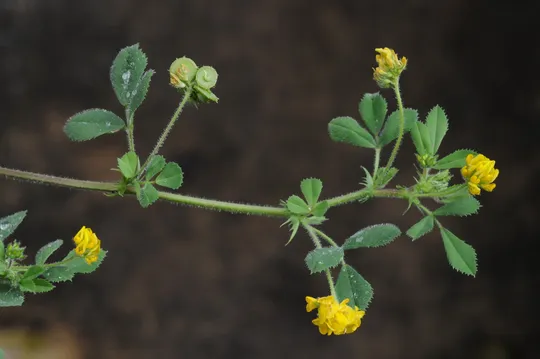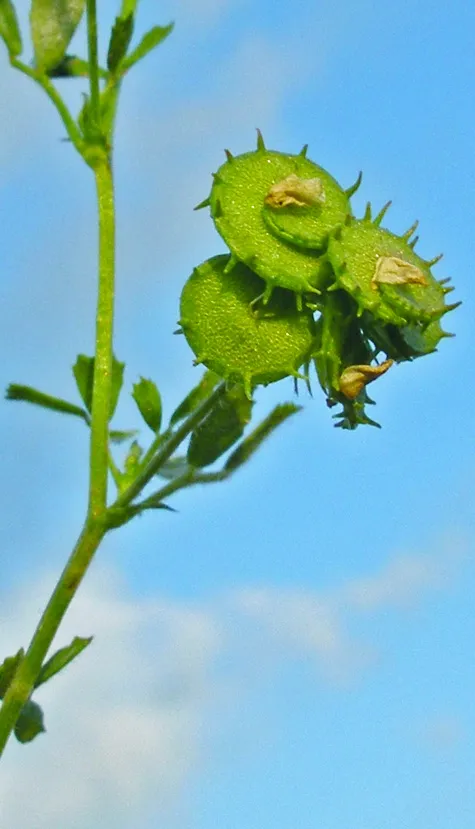Hairy Medick
Medicago italica




Medicago italica is an annual, prostrate, hairy plant. Its stems mostly branch out close to the base of the plant. Leaves are trifoliate; stipules shaped differently than the leaflets. The flowers are grouped into inflorescences of 8-15 at the tops of the stems. Flowers are pea-like (papilionate), yellow, about 4 mm long. The fruit is a flat and discoid pod, without prickles or occasionally with tiny prickles; it is spiral with 1-2.5 coils. The veins on the coils resemble radii facing the center.
Medicago italica was collected in the past from all of the coastal plain regions – Acre
Valley, Carmel Coast, Sharon and the Philistean Plain area, and grows there in
dozens of locations. However, surveys conducted in the 1980s and 90s, did not
find populations which had once existed in in the Acre Valley, the Carmel
Coast, the Philistean Plain region, the Gaza Coast and Judean Mountains. The
species was collected during the first half of the 20th century in
Jerusalem, in 1931 and 1942, and in the spring of 2000 at Burg El-Malih in the
Samarian ecotone (single observation). M.
italica is now found almost exclusively in the Sharon, but
in this region too, the number of locations has decreased, although a number of
new locations, unknown in the past, were discovered. The primary concentrations
of surviving populations are located in the Tel Mond-Ramat HaKovesh-Kadima-Ilanot
region. In addition, a new location near Binyamina was found in Hamra soil.
Sand and hamra-sand soil and fallow sandy fields on
the coastal plain, with a preference for hamra.
The fruit of Medicago
italica is primarily characterized compared to other Medicago species, by
the small number of coils and their vein pattern and by its prickles that are tiny or withered. M. littoralis is a closely related species, which is the most common species along
Israel’s shores, and whose fruit has a larger number of coils as well as
prominent prickles at the edges of the pod (like most Medicago species). M. littoralis also has a variety whose prickles are minute,
but it has a greater number of coils (see Aronson’s book, Table D).
In a few locations, there are transition forms
between Medicago littoralis and M. italica e.g., in the sandy area south of Or Akiva between Highway 2 and
Highway 4. In this sandy area, there is a dense population of M. littoralis, including specimens with a small number of coils and small prickles; the encircling vein of the coil is delicate and the coil is very
thin. Clara Chen, the world expert, identified the plants as M. italica. However,
as transitions such as these between the two species, have been observed in
additional locations on the coast, it is possible that there is room for
additional field research in Israel in order to establish the separation of M. italica and M. littoralis into two different taxa. Hopefully, until then, the populations on the
coastal plain will not become extinct.
·
Destruction of the natural
habitats of hamra sand on the coastal plain is the primary cause of the
extinction of these populations, and the decrease in the number of regions and
locations. It is unclear why most of the populations survived specifically in
the Sharon, and not in other coastal plain regions, despite the widespread
agricultural and urban development in this area.
·
M. italica grows
in patches of dozens to hundreds of plants in areas of a few meters to dozens
of meters. Population fragmentation corresponds to habitat fragmentation.
·
Information is lacking
regarding the annual demographic trends and population size fluctuation at each
of the locations.
·
The species is found in all
of the countries around the Mediterranean Sea and is apparently not globally endangered.
·
The plant is protected in the
Kadima Reserve.
Additional populations of Medicago italica should be searched for in all of the coastal plain regions. Demographic
tracking of the familiar populations, can clarify long-term trends in population
stability. The species should be naturalized in appropriate soil at the Benne
Tsion and Wadi Poleg reserves.
The Mediterranean Sea Basin and the Mediterranean
Sea Islands – Spain, Portugal, Italy, Sardinia, Sicily, Malta, Libya, Tunis,
Algeria, Morocco, Israel and Jordan.
Medicago italica is an annual plant growing in sandy habitats along the coastal plain.
It is classified as a threatened red plant due to habitat loss. It survives in
just one region out of the five where it previously grew on the coastal plain.
Its rarity is related to its status as a peripheral species whose primary
distribution extends over the Mediterranean countries north of Israel. A year-round
monitoring system should track the known populations and attempts should be
made to grow it within reserves, together with additional rare coastal plain psammophilous
species.
Heyn, C.C.1963 The annual species of Medicago. Scr. Hierosolymthana, 12:1–154.
אתר אינטרנט:
ILDIS – International Legume Database & Information Service
http://www.ildis.org/
Current Occupancy Map
| 1000 squre meter pixel | 5000 squre meter pixel | 10000 squre meter pixel | |
|---|---|---|---|
| number of observations | 0 | 0 | 0 |
| in total pixels | 0 | 0 | 0 |
| Family | Fabaceae |
| Classification | On the endangered species list |
| Ecosystem | Coastal area |
| Chorotype | Mediterranean |
| Conservation Site | Kadima Nature Reserve |
| Rarity |
1
2
6
|
|---|---|
| Vulnerability |
0
4
4
|
| Attractiveness |
0
0
4
|
| Endemism |
0
0
4
|
| Red number |
1
3.7
10
|
| Peripherality | N |
| IUCN category | DD EW EX LC CR EN VU NT |
| Threat Definition according to the red book | Vulnerable |
 Based on:
Based on:






